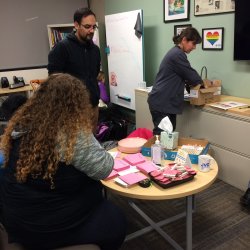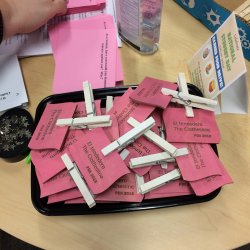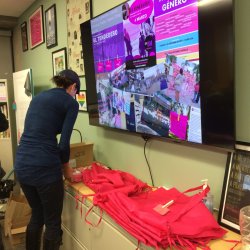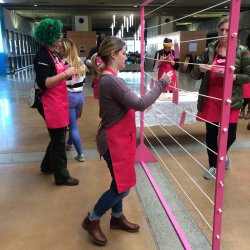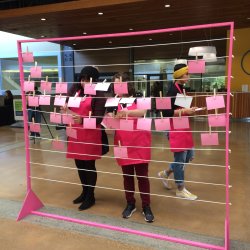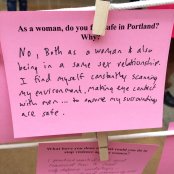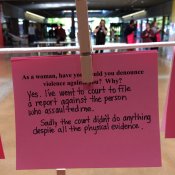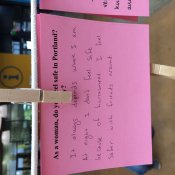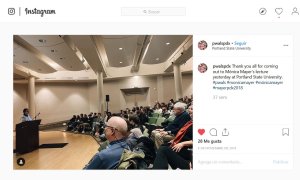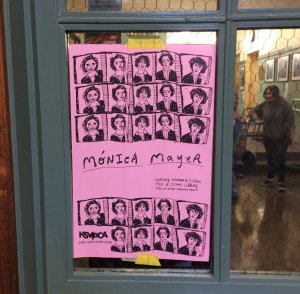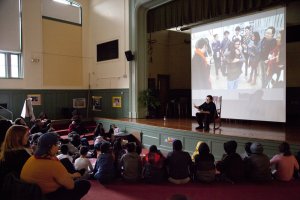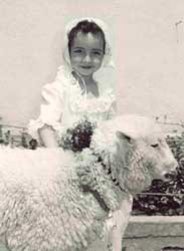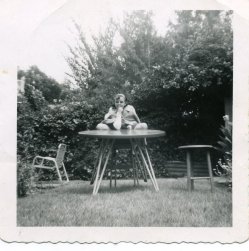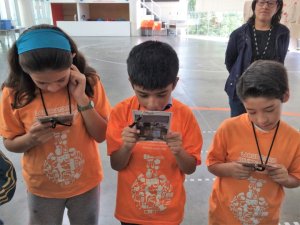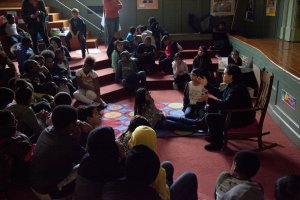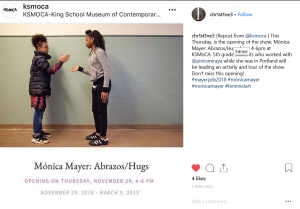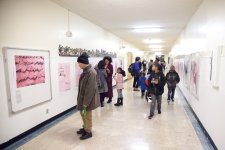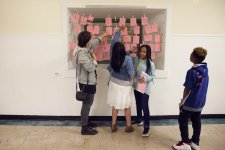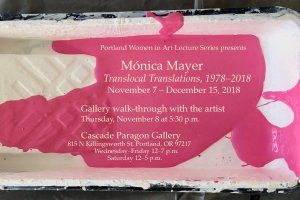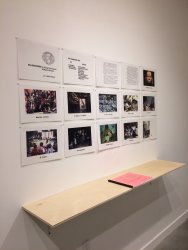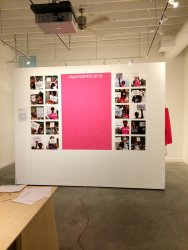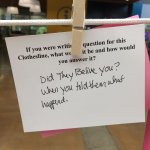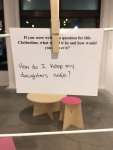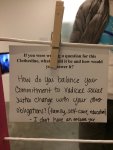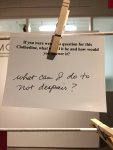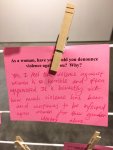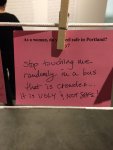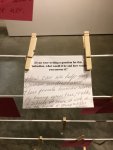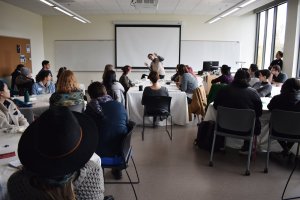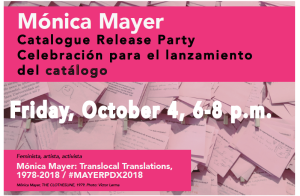The invitation to carry out El Tendedero in Portland began to take shape towards the end of 2017, when Alberto McKelligan informed me that, from his new position at Portland State University, he was collaborating with the organizers of The Women in Arts Lecture Series Committee and they were interested in having me give a lecture in the fall of 2018. What seemed like a simple talk, turned into a compact and intense four-day project that included two workshops, two Tendederos, an exhibition, and 4 lectures.
I met Alberto when he was working on his PHD dissertation, which he presented in 2017, titled "Mónica Mayer: Translocality and the Development of Feminist Art in Contemporary Mexico" (2017). I gladly accepted his invitation because I consider it an honor that someone would study my work so thoroughly. His work was awarded the Carolyn G. Heilburn Dissertation Prize.
My arrival in Portland on November 5th was a bit complicated and, for the first time in my life, I was stopped at immigration for over an hour and questioned about my activities in the United States, despite having letters from the universities and schools where I would be presenting my work and a return ticket.
The next day I facilitated a workshop at the Women's Resource Center at Portland Community College Sylvania, which also joined the project. In this case, since we had limited time, I shared information about previous Tendederos, gave them tips on how to invite the public to participate, and we jumped right into it. The good thing is that when you work with women who are dedicated to addressing the issue of harassment through art or institutionally, you can skip half of the information, and it's easy to be on the same page.
The questions for this Tendedero were:
- As a woman, have you experienced violence or harassment? What happened?
- As a woman, have you/would you denounce violence against you? Why?
- As a woman, where do you feel safe in Portland? Why?
- What have you done or what could you do to stop violence against women?
In order to allow the community participating in this Tendedero, whether in the workshop or by answering the questions, to address other issues, they came up with one more question on a white paper: 5. If you were writing a question for this Tendedero, what would it be, and how would you answer it? I thought that was brilliant.
I loved that instead of using printed aprons for the persons activating El Tendedero, which we often wear so people can identify we are part of a project, they made these adorable clothespin badges. New ideas always emerge with each Tendedero.
Armed with our aprons, clothespins and the desire to initiate a dialogue about harassment in this institution, we went out to seek for responses. Unfortunately, as it often happens, the clothesline structure filled up in no time.
These are some of the answers:
On Wednesday morning I explored Portland and, in the afternoon, I gave the keynote lecture titled "Translocal Translations: Feminist Art in Contemporary Mexico. A Few Decades, a Few Works, and Some Anecdotes" during which I discussed my artworks from the 1970’s while studying in Los Angeles, as well as contemporary drawings and performances.
The event took place at the Lincoln Recital Hall at Portland State University, and it was attended by a very receptive audience.
After the talk, a young person approached me to show me his drawings. Unfortunately, I didn't get his contact information, but I enjoyed his drawings.
Thursday, November 8th, was the busiest day and one of the greatest challenges I have faced as an artist. I went to King School, which is an elementary school, to give a talk to the young students, followed by a workshop where we reactivated Abrazos (Hugs), a performance Víctor Lerma and I began in 2008, and we also worked on their responses to their own El Tendedero project. The documentation of both exercises was presented as an exhibition at the school in late November. I found it inspiring that this was the first school in the United States to be named after Martin Luther King, shortly after his assassination.
Photo Anke Schuettler, KSMoCA
Giving this lecture was complex. It is not easy for me to explain conceptual art projects to young and curious individuals, particularly from a different culture, even though they had been previously introduced to my work. As part of the KSMoCA project, which brings contemporary art to the elementary school, they had been given a fun fanzine explaining my works.
I tried to share the idea of performance art in a playful way. For example, regarding Translations: An International Dialogue of Women Artists, I told them it was a way of building a bridge. To talk about ¡MADRES! the performance Maris Bustamante and I as the feminist art collective Polvo de Gallina Negra (Black Hen’s Dust) on Guillermo Ochoa’s television program where we named him Mother for a Day https://youtu.be/oPu9-XWFzCk, I explained it was role playing. For Carta a mi Madre (Letter to My Mother), which was also a piece by Polvo de Gallina Negra, I told them it was about writing a secret message, and I said that El Tendedero was a way of inviting everyone to participate. Finally, Abrazos (Hugs), the piece we were going to reactivate, was simply a way to share stories.
To try to connect, I started the lecture by showing them two photos of myself at their age. The first one was when I recited Mary had a little lamb in kindergarten, and they were only able to get a sheep which was so big it almost pulled me out of the stage, and the second one was me imitating my sixth-grade teacher.
I ended the lecture with a photo of one of the iterations of Abrazos at the Museo Universitario de Arte Contemporáneo (MUAC) in 2016 during a summer course at the museum.
Photo Anke Schuettler, KSMoCA
To set the stage, I asked them to lend me a rocking chair that was around, assuming the role of a grandmother, which I love. We engaged in an intense dialogue for a few minutes, until they got bored.
We then moved to the workshop, and it was very interesting because their regular teachers, art teachers, and a bunch of university assistants supporting the project were present. However, it was challenging for me, and I had to improvise along the way. I'm not used to working with children, especially in the United States.
I had initially planned to do all of this during the workshop, but I didn't take into account that many pre-teens don't like hugs, especially with their classmates. As a result, they ended up designing different ways to greet each other, which was a lot of fun.
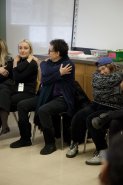
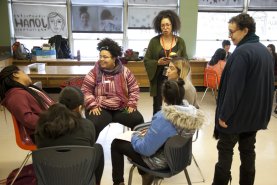
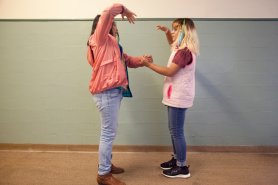
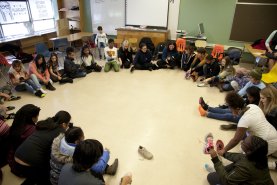
Photo Anke Schuettler, KSMoCA
At a certain point, I came up with the idea of playing the Mexican song called Acitrón de un Fandango and passing something around in a circle to synchronize the group, but it turned into chaos. Fortunately, the teachers redirected the activity. The day ended with them responding to the question for this unique Tendedero which was: "What would make you happier at your school?"
Halfway through the workshop, the alarms went off because a drill was programmed and we all had to evacuate the school and go to a field nearby.
This is the invitation to the exhibition that took place on November 29th and some of its photographs.
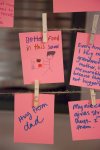
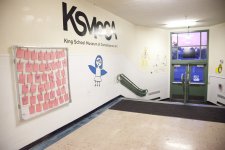
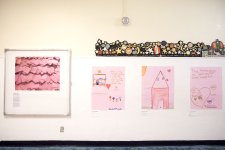
Photo Anke Schuettler, KSMoCA
I was exhausted, but there was still a lot ahead.
The next stop was the opening of my exhibition Translocal Translations, 1978-2018 at the Cascade Pragon Gallery, where I also gave a guided tour to a full house. The gallery is small, but they did an excellent job of displaying El Tendedero and several other pieces, including Lo Normal, Traducciones, Maternidades Secuestradas, and the video of Madre por un día by Polvo de Gallina Negra.
Since it was a university gallery without budget for international artwork shipments, insurance, etc., we presented a couple of facsimiles and documentation, which can be reproduced without altering its essence. I like doing exhibitions this way because I simply send the images, and they are produced on-site according to their specific size requirements.
In this exhibition, El Tendedero had a prominent place, and they arranged the space well for the audience to sit and respond or read some of the feminist art bibliography they made available.
Here are some of the responses.
But the day turned into night, and after the opening, there was a dinner for academics from Portland Community College at the June Key Delta Community Center, where I gave a brief speech and engaged in a dialogue. By that point, I was so tired that I can't even remember what I talked about.
It was a long, exhausting, productive, and interesting day.
Photo Anke Schuettler, KSMoCA
On the last day of this intense trip, I was invited to the Rising Stars Luncheon program at the PCC Rock Creek Campus, where I had a dialogue with students. Then they took me to visit their Women's Resource Center. I love the attention that U.S. universities pay to gender issues.
Although the trip was intense, I was grateful to all the institutions, programs, and people who collaborated to make it possible. The icing on the cake was that they published a catalogue of all of these activities.
The Catalogs of the Tendederos de Portland / The Portland Clotheslines
Since I was at art school in Mexico City during the early seventies, I have understood the importance of having a catalog after every exhibition. Unfortunately, I haven't always achieved that goal, although I have tried to document all my work. That's why I am immensely happy that the Tendedero de Portland / Portland Clothesline project produced two catalogs.
The first one was about the collaboration between KSMoCA, the students from Dr. Martin Luther King Jr. School, and myself. In this collaboration, after a lecture and a workshop, the students created a series of drawings depicting the hugs that had been important to them. Later, these drawings of hugs were presented as a Tendedero, along with documentation of previous iterations of the artwork. Some of the hug drawings are deeply moving. Take a look at them here.
The second catalog encompasses the rest of the activities during this visit, including talks and the exhibition at the Paragon Gallery. The catalog features texts by Christine Weber and Alberto McKelligan Hernández. You can find the catalog here.
It's worth mentioning that both catalogs are bilingual.


